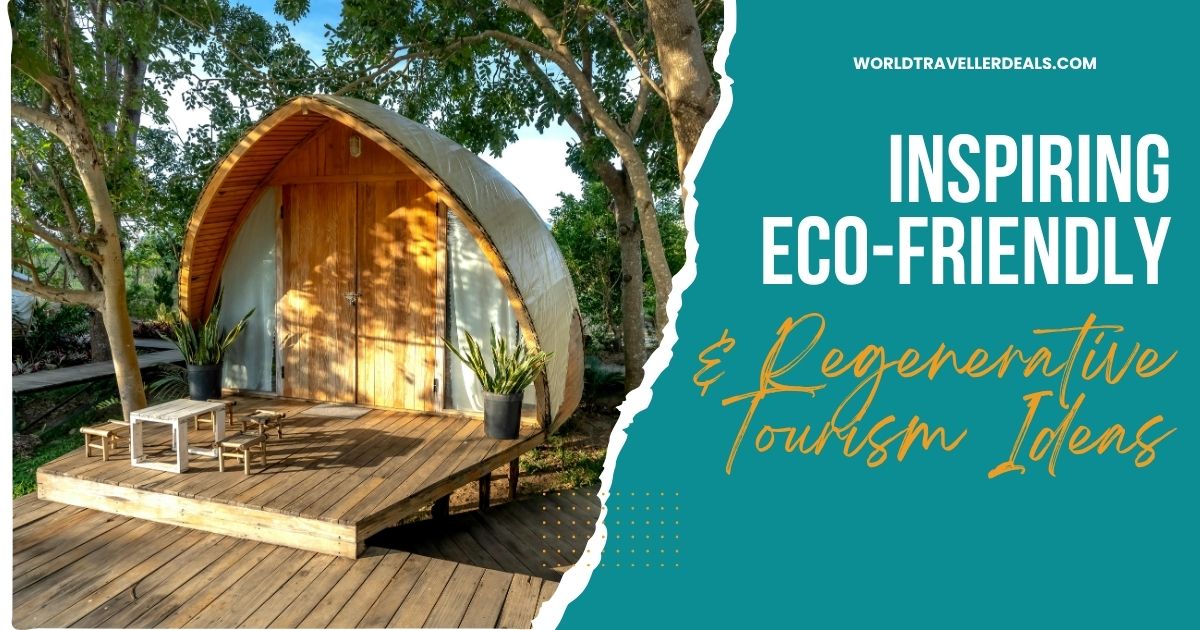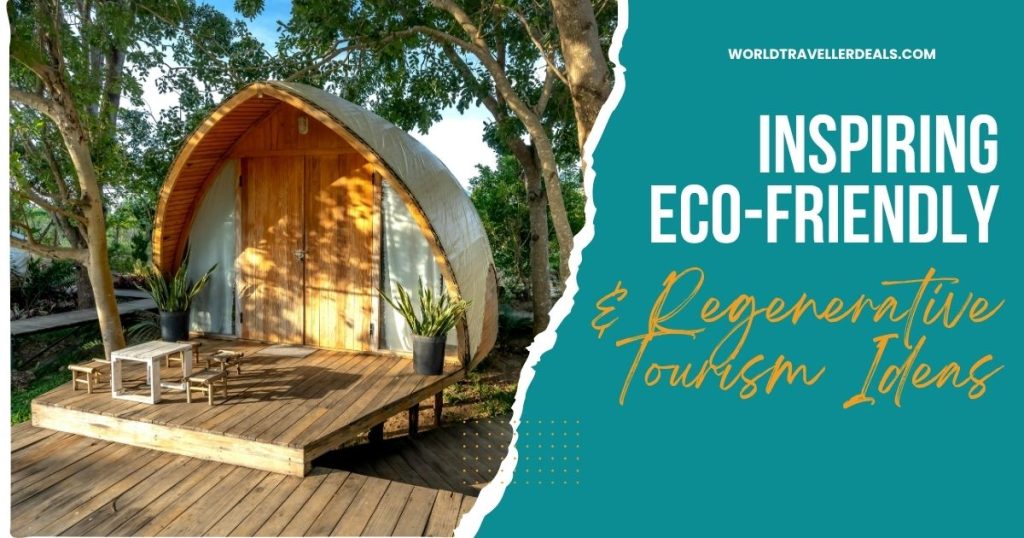
10 Inspiring Eco-Friendly & Regenerative Tourism Ideas

Travel is one of the most rewarding and enriching experiences we can undertake. Exploring new cultures, landscapes, and lifestyles broadens perspectives and creates lasting memories. However, conventional tourism can come at a high environmental and social cost. From over-tourism in fragile ecosystems to excessive waste and energy consumption, the impact of travel on our planet is undeniable.
As travelers become more conscious of their footprint, eco-friendly and regenerative tourism has emerged as a movement that allows people to explore the world responsibly. This approach goes beyond reducing harm; it actively contributes to the restoration and sustainability of the destinations we visit. By choosing regenerative practices, travelers can leave places better than they found them, support local communities, and reconnect with nature in meaningful ways.
This article explores eco-friendly and regenerative tourism ideas, practical ways to implement them, inspiring examples, and why this approach is essential for the future of travel.
Understanding Eco-Friendly and Regenerative Tourism
Eco-friendly tourism, often called sustainable tourism, focuses on minimizing negative environmental impacts. It involves making choices that reduce waste, conserve natural resources, and respect local communities. Examples include staying in energy-efficient accommodations, reducing plastic use, and supporting local businesses.
Regenerative tourism goes one step further. It is not just about doing less harm; it is about actively improving the environment, culture, and economy of a destination. This could involve participating in beach cleanups, supporting reforestation projects, or engaging in community-led cultural experiences. While sustainable tourism asks travelers to be mindful, regenerative tourism invites them to contribute and leave a positive legacy.
By combining eco-friendly and regenerative practices, travelers can enjoy transformative experiences that nurture both the planet and the soul.
Eco-Friendly Travel Ideas
1. Choose Green Accommodations
Selecting eco-conscious lodging is one of the easiest ways to travel sustainably. Many hotels and resorts now adhere to environmental certifications such as LEED, Green Globe, or EarthCheck. These accommodations use renewable energy, conserve water, recycle waste, and often source local, organic food.
For example, in Costa Rica, eco-lodges nestled in rainforest canopies allow guests to experience the jungle while minimizing their impact. In Scandinavia, energy-efficient cabins with solar panels and low-water systems offer modern comfort with a minimal footprint. Even in urban settings, boutique hotels that implement green practices provide travelers the opportunity to stay sustainably without sacrificing style.
2. Travel by Low-Impact Transportation
Air travel contributes significantly to carbon emissions, so minimizing flights or offsetting your footprint is crucial. Consider train travel or buses for regional trips, and explore destinations that allow walking, cycling, or public transport.
Europe’s extensive rail networks make eco-friendly travel convenient and comfortable. Japan’s Shinkansen trains combine speed with energy efficiency, and many cities worldwide now offer electric bike rentals for sightseeing. When flights are unavoidable, carbon offset programs allow travelers to invest in renewable energy or reforestation projects to balance their emissions.
3. Pack Light and Mindfully
Lightweight luggage is not just convenient; it reduces fuel consumption on flights and other forms of transport. Packing versatile clothing, reusable water bottles, and eco-friendly toiletries helps minimize waste and energy use. Avoid single-use plastics and opt for biodegradable or refillable products.
Packing fewer electronics and chargers also reduces energy consumption and encourages travelers to be present in the moment rather than constantly connected. Simple steps like this make a significant difference over multiple trips.
4. Support Local and Ethical Businesses
Where you spend your money can have a lasting impact. Choose locally owned restaurants, artisan shops, and tour operators that employ residents and respect cultural traditions. Avoid businesses that exploit wildlife or promote cultural insensitivity.
For example, instead of visiting a generic souvenir shop in Bali, support artisans who create handmade batik or silver jewelry. In Kenya, choose safari operators who adhere to ethical wildlife practices, ensuring animals are observed responsibly and habitats are protected. Every dollar spent locally helps strengthen the economy and preserve cultural heritage.
5. Reduce Waste and Embrace Zero-Waste Practices
Travelers generate significant waste through disposable packaging, bottles, and food containers. Minimizing waste starts with simple habits: carry a reusable water bottle, tote bag, and utensils, and refuse single-use plastics wherever possible.
Participating in local recycling programs and disposing of trash responsibly shows respect for communities and ecosystems. In remote destinations, even biodegradable waste can disrupt local flora and fauna, so responsible disposal is essential. Travelers can also choose accommodations or tours that prioritize zero-waste practices, further reducing environmental impact.
Regenerative Tourism Ideas
1. Volunteer for Environmental Projects
Regenerative tourism encourages hands-on involvement in conservation efforts. Volunteering with local organizations can make a tangible difference. Activities might include planting trees, restoring coral reefs, or participating in wildlife monitoring programs.
Costa Rica offers rainforest conservation programs where travelers can help protect endangered species while learning about ecology. In Thailand, coral restoration projects allow divers to assist in reef recovery while gaining insight into marine biology. These experiences not only benefit the environment but also deepen the traveler’s understanding and connection to the destination.
2. Engage with Community-Led Experiences
Participating in community-led cultural experiences supports local livelihoods and preserves traditions. This could include cooking classes, handicraft workshops, or guided tours led by residents who share stories and skills passed down through generations.
For example, in Morocco, travelers can learn traditional pottery or rug weaving directly from artisans, creating meaningful interactions that sustain cultural heritage. In New Zealand, Māori communities offer immersive tours that combine storytelling, music, and history, fostering mutual respect and understanding. By engaging with locals, travelers contribute to cultural preservation and empower communities.
3. Participate in Citizen Science
Many destinations offer citizen science programs where travelers can contribute to research while exploring nature. This could involve wildlife monitoring, bird counts, or plant surveys.
In Australia, visitors can help track endangered sea turtles along the coastline. In the Amazon, guided tours often invite tourists to record biodiversity observations, contributing to long-term conservation studies. Citizen science initiatives provide travelers with a sense of purpose and create data that aids environmental protection.
4. Support Regenerative Agriculture and Food Tourism
Food tourism can be a powerful way to engage with local sustainability practices. Visiting farms, vineyards, or permaculture projects allows travelers to understand and support regenerative agriculture.
In Tuscany, Italy, agritourism experiences allow visitors to help harvest olives or grapes, learn traditional farming methods, and enjoy farm-to-table meals. In California, regenerative vineyards showcase soil health and biodiversity, inviting guests to see the connection between sustainable farming and delicious produce. Supporting these initiatives encourages food systems that restore the land rather than deplete it.
5. Offset Carbon and Invest in the Planet
While eco-friendly travel minimizes harm, regenerative tourism actively improves the planet. Travelers can contribute by supporting local environmental projects, purchasing carbon offsets, or investing in renewable energy initiatives.
Many organizations offer tree planting programs, mangrove restoration, or community solar projects where funds directly benefit ecosystems and communities. By taking responsibility for the environmental impact of travel, visitors leave a lasting positive legacy.
Inspiring Eco-Friendly Destinations
1. Costa Rica
Known for its biodiversity and conservation efforts, Costa Rica offers a wide range of eco-lodges, wildlife sanctuaries, and adventure tours that prioritize sustainability. The country’s national parks, rainforests, and beaches are perfect for regenerative travel experiences.
2. Iceland
Iceland’s commitment to renewable energy and natural preservation makes it an ideal destination for eco-conscious travelers. Visitors can explore glaciers, volcanoes, and hot springs with minimal environmental impact, thanks to strict regulations and eco-tourism practices.
3. New Zealand
New Zealand blends adventure tourism with sustainability. From Māori cultural tours to hiking in protected national parks, travelers can engage in regenerative tourism while experiencing breathtaking landscapes.
4. Japan
Japan offers unique opportunities for responsible tourism, from visiting eco-friendly ryokans and participating in forest bathing experiences to exploring traditional agriculture practices in rural villages.
5. Kenya
Kenya’s wildlife conservancies provide travelers with ethical safari experiences. Visitors can support anti-poaching initiatives, community projects, and habitat restoration while witnessing Africa’s incredible wildlife in its natural environment.
Tips for Practicing Eco-Friendly and Regenerative Travel
- Plan Ahead: Research destinations, accommodations, and tours that align with sustainability goals.
- Travel Slowly: Extend stays to reduce frequent transport emissions and immerse yourself in local culture.
- Respect Wildlife: Observe animals responsibly and avoid attractions that exploit or harm them.
- Educate Yourself: Learn about local customs, environmental challenges, and conservation efforts.
- Share Responsibly: Use social media to promote awareness without encouraging over-tourism in fragile areas.
Why Eco-Friendly and Regenerative Tourism Matters
Travel shapes both our worldview and the destinations we visit. Traditional tourism can generate income and support economies, but without careful planning, it can harm ecosystems, disrupt local communities, and erode cultural heritage.
Eco-friendly tourism ensures that our footprint is light, while regenerative tourism empowers travelers to make positive change. Both approaches benefit not only the planet but also the traveler’s experience. By engaging thoughtfully, visitors can create meaningful connections, witness authentic cultural practices, and feel fulfilled knowing their actions make a difference.
Sustainable travel is no longer a niche. As environmental awareness grows, more travelers seek experiences that align with their values. Governments, tour operators, and local communities also increasingly recognize the importance of responsible tourism, offering certifications, ethical guidelines, and regenerative initiatives that travelers can support.
Ultimately, every choice matters. From packing a reusable water bottle to volunteering for a beach cleanup, small actions add up. By embracing eco-friendly and regenerative tourism, travelers become part of a movement that preserves the beauty, culture, and health of the planet for future generations.
Embracing Eco-Friendly and Regenerative Tourism
Traveling responsibly doesn’t mean giving up adventure or comfort. Choosing eco-friendly accommodations, low-impact transportation, and activities that support local communities lets you explore new places while leaving them better than you found them. Volunteering, joining citizen science projects, or taking part in cultural experiences creates deeper connections and makes your trip feel more meaningful.
Small choices, like reducing waste, supporting local artisans, or offsetting your carbon footprint, really add up over time. These simple actions help preserve nature, wildlife, and traditions for the future. By traveling with care, you not only enjoy richer, more authentic experiences but also make a positive impact that lasts long after your journey ends.